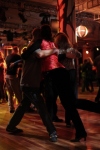I haven’t stopped dancing, its just that I changed companies and WordPress is blocked at work and I’m usually too tired/busy after work to write new entries … I’ve been dancing less lately, partly due to other things happening in life and partly due to not really having a great time in milongas.
One thing that really kills it for me is when I’m trying to cabeceo a lady for a dance, some sod comes up and sticks their hands out to invite the woman, and the woman accepts. So if I’m in an environment where walking up to invite is so common, what do I do?
Javier was talking about codigos recently and I was lucky enough to attend his very popular classes. He promotes the cabeceo without any reservations and he talking about various strategies to use and educate it.
Disclaimer: what I present below is what I made out from his broken English (which is getting a lot better) and also the interpreter’s broken English. Javier may have been tying to make an entirely different point but these are what I think he was saying.
Firstly, never walk up to a woman and invite her to dance. If she’s not someone who uses the cabeceo much (or at all), you can walk up to her, chat but do not invite her to dance. Instead, ask if she wants to dance to XYZ orchestra later when it comes on. (Of course, if that orchestra doesn’t come on then this may not work). But the idea is to suggest to her to look for you at a later time in the evening.
And for the women, saying no is nasty. Its not nice to say it and its even worse to receive it. When a particular poor dancer or beginner who does not know the cabeceo walks up to invite, there are ways to reject them and not make them feel so bad. The suggestion first involved saying yes – you will help them by going to classes with them (if you want) or practising with them so that they get better. But no, you will not dance with them at this particular time because you want to dance with XYZ over there who instead.
I have read that no is no and women don’t ever need to explain why, but I’ve been on the receiving end of many rejections and its never nice. If you’re in a particularly quiet milonga, it can get a little awkward as well and I do think Javier’s suggestions of saying yes to say no is nice.


